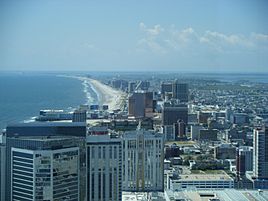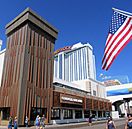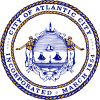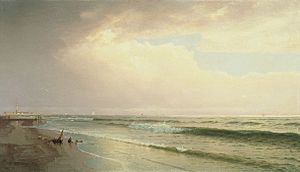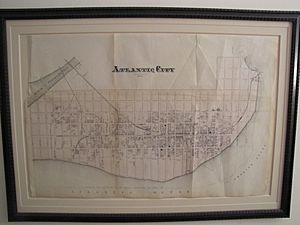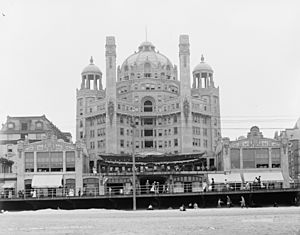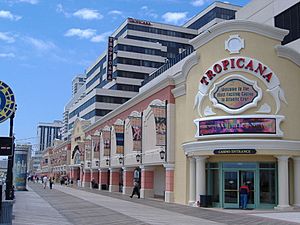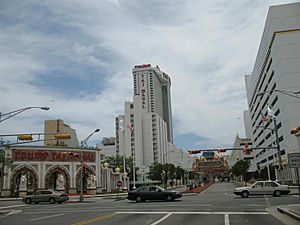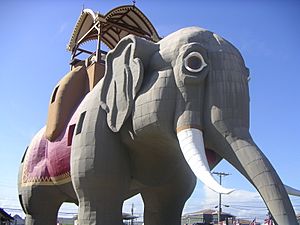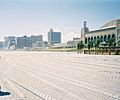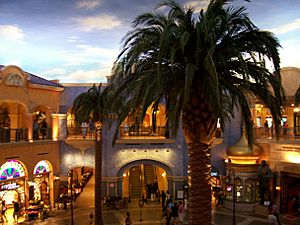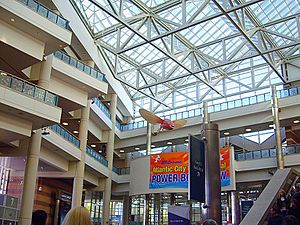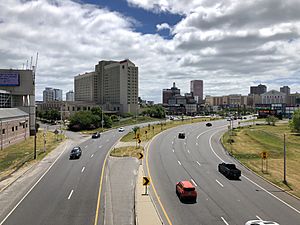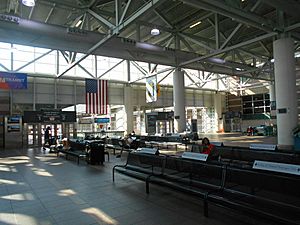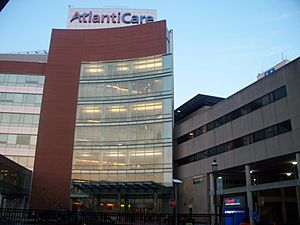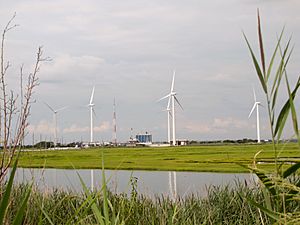Atlantic City, New Jersey facts for kids
Quick facts for kids
Atlantic City, New Jersey
|
|||||
|---|---|---|---|---|---|
|
City
|
|||||
| City of Atlantic City | |||||
|
From top, left to right: Atlantic City skyline; the Ocean Casino Resort in the afternoon ; Hard Rock; Boardwalk Hall; Ritz-Carlton Atlantic City; The Quarter at Tropicana; and Ballys
|
|||||
|
|||||
| Nicknames:
Monopoly City
"The World's Famous Playground" |
|||||
| Motto(s):
Consilio et Prudentia (Latin)
"By Counsel and Wisdom" |
|||||
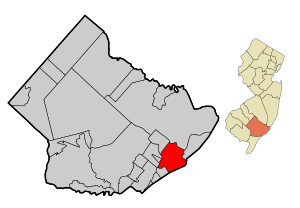
Location within Atlantic County
|
|||||
| Country | |||||
| State | |||||
| County | Atlantic | ||||
| Incorporated | May 1, 1854 | ||||
| Government | |||||
| • Type | Faulkner Act (mayor–council) | ||||
| • Body | City Council | ||||
| Area | |||||
| • City | 17.21 sq mi (44.59 km2) | ||||
| • Land | 10.76 sq mi (27.87 km2) | ||||
| • Water | 6.45 sq mi (16.72 km2) 37.50% | ||||
| Area rank | 165th of 565 in state 8th of 23 in county |
||||
| Elevation | 7 ft (2 m) | ||||
| Population | |||||
| • City | 38,497 | ||||
| • Rank | 61st of 566 in state 2nd of 23 in county |
||||
| • Density | 2,236.9/sq mi (863.36/km2) | ||||
| • Density rank | 171st of 566 in state 3rd of 23 in county |
||||
| • Metro | 275,549 | ||||
| Time zone | UTC−05:00 (EST) | ||||
| • Summer (DST) | UTC−04:00 (Eastern (EDT)) | ||||
| ZIP Codes |
08401–08406
|
||||
| Area code(s) | 609 | ||||
| FIPS code | 3400102080 | ||||
| GNIS feature ID | 0885142 | ||||
Atlantic City, often known by its initials A.C., is a coastal resort city in Atlantic County, New Jersey, United States, known for its casinos, boardwalk, and beaches. In 2020, the city had a population of 38,497. It was incorporated on May 1, 1854, from portions of Egg Harbor Township and Galloway Township. It is located on Absecon Island and borders Absecon, Brigantine, Pleasantville, Ventnor City, Egg Harbor Township, and the Atlantic Ocean.
Atlantic City inspired the U.S. version of the board game Monopoly, especially the street names. Since 1921, Atlantic City has been the home of the Miss America pageant. In 1976, New Jersey voters legalized casino gambling in Atlantic City, and the first casino opened in 1978.
Contents
History
Early days
Because of its location in South Jersey, hugging the Atlantic Ocean between marshlands and islands, Atlantic City was viewed by developers as prime real estate and a potential resort town. In 1853, the first commercial hotel, the Belloe House, was built at the intersection of Massachusetts and Atlantic Avenues.
The city was incorporated in 1854, the same year in which the Camden and Atlantic Railroad train service began. Built on the edge of the bay, this served as the direct link of this remote parcel of land with Philadelphia, Pennsylvania. That same year, construction of the Absecon Lighthouse, designed by George Meade of the Corps of Topographical Engineers, was approved, with work initiated the next year. By 1874, almost 500,000 passengers a year were coming to Atlantic City by rail. In Boardwalk Empire: The Birth, High Times, and Corruption of Atlantic City, "Atlantic City's Godfather" Nelson Johnson describes the inspiration of Dr. Jonathan Pitney (the "Father of Atlantic City") to develop Atlantic City as a health resort, his efforts to convince the municipal authorities that a railroad to the beach would be beneficial, his successful alliance with Samuel Richards (entrepreneur and member of the most influential family in southern New Jersey at the time) to achieve that goal, the actual building of the railroad, and the experience of the first 600 riders, who "were chosen carefully by Samuel Richards and Jonathan Pitney":
- "After arriving in Atlantic City, a second train brought the visitors to the door of the resort's first public lodging, the United States Hotel. The hotel was owned by the railroad. It was a sprawling, four-story structure built to house 2,000 guests. It opened while it was still under construction, with only one wing standing, and even that wasn't completed. By year's end, when it was fully constructed, the United States Hotel was not only the first hotel in Atlantic City but also the largest in the nation. Its rooms totaled more than 600, and its grounds covered some 14 acres."
The first boardwalk was built in 1870 along a portion of the beach in an effort to help hotel owners keep sand out of their lobbies. Businesses were restricted and the boardwalk was removed each year at the end of the peak season. Because of its effectiveness and popularity, the boardwalk was expanded in length and width, and modified several times in subsequent years. The historic length of the boardwalk, before the destructive 1944 Great Atlantic Hurricane, was about 7 miles (11 km) and it extended from Atlantic City to Longport, through Ventnor and Margate.
The first road connecting the city to the mainland at Pleasantville was completed in 1870 and charged a 30-cent toll. Albany Avenue was the first road to the mainland available without a toll.
By 1878, because of the growing popularity of the city, one railroad line could no longer keep up with demand. Soon, the Philadelphia and Atlantic City Railway was also constructed to transport tourists to Atlantic City. At this point massive hotels like The United States and Surf House, as well as smaller rooming houses, had sprung up all over town. The United States Hotel took up a full city block between Atlantic, Pacific, Delaware, and Maryland Avenues. These hotels were not only impressive in size, but featured the most updated amenities, and were considered quite luxurious for their time.
Boom period
In the early part of the 20th century, Atlantic City went through a radical building boom. Many of the modest boarding houses that dotted the boardwalk were replaced with large hotels. Two of the city's most distinctive hotels were the Marlborough-Blenheim Hotel and the Traymore Hotel.
In 1903, Josiah White III bought a parcel of land near Ohio Avenue and the boardwalk and built the Queen Anne style Marlborough House. The hotel was a hit and, in 1905–06, he chose to expand the hotel and bought another parcel of land next door to his Marlborough House. In an effort to make his new hotel a source of conversation, White hired the architectural firm of Price and McLanahan. The firm made use of reinforced concrete, a new building material invented by Jean-Louis Lambot in 1848 (Joseph Monier received the patent in 1867). The hotel's Spanish and Moorish themes, capped off with its signature dome and chimneys, represented a step forward from other hotels that had a classically designed influence. White named the new hotel the Blenheim and merged the two hotels into the Marlborough-Blenheim. Bally's Atlantic City was later constructed at this location.
The Traymore Hotel was located at the corner of Illinois Avenue and the boardwalk. Begun in 1879 as a small boarding house, the hotel grew through a series of uncoordinated expansions. By 1914, the hotel's owner, Daniel White, taking a hint from the Marlborough-Blenheim, commissioned the firm of Price and McLanahan to build an even bigger hotel. Rising 16 stories, the tan brick and gold-capped hotel would become one of the city's best-known landmarks. The hotel made use of ocean-facing hotel rooms by jutting its wings farther from the main portion of the hotel along Pacific Avenue.
One by one, additional large hotels were constructed along the boardwalk, including the Brighton, Chelsea, Shelburne, Ambassador, Ritz Carlton, Mayflower, Madison House, and the Breakers. The Quaker-owned Chalfonte House, opened in 1868, and Haddon House, opened in 1869, flanked North Carolina Avenue at the beach end. Over the years, their original wood-frame structures would be enlarged, and even moved closer to the beach. The modern Chalfonte Hotel, eight stories tall, opened in 1904. The modern Haddon Hall was built in stages and was completed in 1929, at eleven stories. By this time, they were under the same ownership and merged into the Chalfonte-Haddon Hall Hotel, becoming the city's largest hotel with nearly 1,000 rooms. By 1930, the Claridge, the city's last large hotel before the casinos, opened its doors. The 400-room Claridge was built by a partnership that included renowned Philadelphia contractor John McShain. At 24 stories, it would become known as the "Skyscraper By The Sea." The city became known as the "The World's Playground.
In 1883, salt water taffy was conceived in Atlantic City by David Bradley. The traditional story is that Bradley's shop was flooded after a major storm, soaking his taffy with salty Atlantic Ocean water. He sold some "salt water taffy" to a girl, who proudly walked down to the beach to show her friends. Bradley's mother was in the back of the store when the sale was made, and loved the name, and so salt water taffy was born.
Prohibition era
During this time, Atlantic City was under the mayoral reign of Edward L. Bader, known for his contributions to the construction, athletics and aviation of Atlantic City. Despite the opposition of many others, he purchased land that became the city's municipal airport and high school football stadium, both of which were later named Bader Field in his honor. He led the initiative, in 1923, to construct the Atlantic City High School at Albany and Atlantic Avenues. Bader, in November 1923, initiated a public referendum, during the general election, at which time residents approved the construction of a Convention Center. The city passed an ordinance approving a bond issue for $1.5 million to be used for the purchase of land for Convention Hall, now known as the Boardwalk Hall, finalized September 30, 1924. Bader was also a driving force behind the creation of the Miss America competition.
Nightclub era
The 1930s through the 1960s were a heyday for nightclub entertainment. Popular venues on the white-populated south side included the 500 Club, the Clicquot Club, and the Jockey Club. On the north side, home to African Americans in the racially segregated city, a black entertainment district reigned on Kentucky Avenue. Four major nightclubs – Club Harlem, the Paradise Club, Grace's Little Belmont, and Wonder Gardens – drew both black and white patrons. During the summer tourist season, jazz and R&B music could be heard into the wee hours of the morning. Soul food restaurants and ribs joints also lined Kentucky Avenue, including Wash's Restaurant, Jerry's and Sap's.
Decline and resurgence
Like many older east coast cities after World War II, Atlantic City became plagued with poverty, crime, corruption, and general economic decline in the mid-to-late 20th century. The neighborhood known as the "Inlet" became particularly impoverished. The reasons for the resort's decline were multi-layered. First, the automobile became more readily available to many Americans after the war. Atlantic City had initially relied upon visitors coming by train and staying for a couple of weeks. The car allowed them to come and go as they pleased, and many people would spend only a few days, rather than weeks. The advent of suburbia also played a significant role. With many families moving to their own private houses, luxuries such as home air conditioning and swimming pools diminished their interest in flocking to the luxury beach resorts during the hot summer. But perhaps the biggest factor in the decline in Atlantic City's popularity came from cheap, fast jet service to other premier resorts, such as Miami Beach and the Bahamas.
The city hosted the 1964 Democratic National Convention which nominated Lyndon Johnson for President and Hubert Humphrey as Vice President. The convention and the press coverage it generated, however, cast a harsh light on Atlantic City, which by then was in the midst of a long period of economic decline. Many felt that the friendship between Johnson and Governor of New Jersey Richard J. Hughes led Atlantic City to host the Democratic Convention.
By the late 1960s, many of the resort's once great hotels were suffering from embarrassing vacancy rates. Most of them were either shut down, converted to cheap apartments, or converted to nursing home facilities by the end of the decade. Prior to and during the advent of legalized gambling, many of these hotels were demolished. The Breakers, the Chelsea, the Brighton, the Shelburne, the Mayflower, the Traymore, and the Marlborough-Blenheim were demolished in the 1970s and 1980s. Of the many pre-casino resorts that bordered the boardwalk, only the Claridge, the Dennis, the Ritz-Carlton, and the Haddon Hall survive to this day as parts of Bally's Atlantic City, a condo complex, and Resorts Atlantic City. The old Ambassador Hotel was purchased by Ramada in 1978 and was gutted to become the Tropicana Casino and Resort Atlantic City, only reusing the steelwork of the original building. Smaller hotels off the boardwalk, such as the Madison also survived.
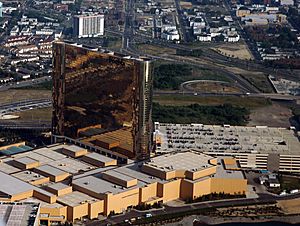
Legalized gambling
In an effort at revitalizing the city, New Jersey voters in 1976 passed a referendum, approving casino gambling for Atlantic City; this came after a 1974 referendum on legalized gambling failed to pass. Immediately after the legislation passed, the owners of the Chalfonte-Haddon Hall Hotel began converting it into the Resorts International. It was the first legal casino in the eastern United States when it opened on May 26, 1978. Other casinos were soon constructed along the Boardwalk and, later, in the marina district for a total of eleven today. The introduction of gambling did not, however, quickly eliminate many of the urban problems that plagued Atlantic City. Many people have suggested that it only served to exacerbate those problems, as attested to by the stark contrast between tourism intensive areas and the adjacent impoverished working-class neighborhoods. In addition, Atlantic City has been less popular than Las Vegas as a gambling city in the United States. Donald Trump helped bring big name boxing bouts to the city to attract customers to his casinos. The boxer Mike Tyson had most of his fights in Atlantic City in the 1980s, which helped Atlantic City achieve nationwide attention as a gambling resort. Numerous highrise condominiums were built for use as permanent residences or second homes. By end of the decade it was one of the most popular tourist destinations in the United States.
Modern day challenges
With the redevelopment of Las Vegas and the opening of two casinos in Connecticut in the early 1990s, along with newly built casinos in the nearby Philadelphia metro area in the 2000s, Atlantic City's tourism began to decline due to its failure to diversify away from gaming. Determined to expand, in 1999 the Atlantic City Redevelopment Authority partnered with Las Vegas casino mogul Steve Wynn to develop a new roadway to a barren section of the city near the Marina. Nicknamed "The Tunnel Project", Steve Wynn planned the proposed 'Mirage Atlantic City' around the idea that he would connect the $330 million tunnel stretching 2.5 miles (4.0 km) from the Atlantic City Expressway to his new resort. The roadway was later officially named the Atlantic City-Brigantine Connector, and funnels incoming traffic off of the expressway into the city's marina district and Brigantine, New Jersey.
Although Wynn's plans for development in the city were scrapped in 2002, the tunnel opened in 2001. The new roadway prompted Boyd Gaming in partnership with MGM/Mirage to build Atlantic City's newest casino. The Borgata opened in July 2003, and its success brought an influx of developers to Atlantic City with plans for building grand Las Vegas style mega casinos to revitalize the aging city.
Owing to economic conditions and the late 2000s recession, many of the proposed mega casinos never went further than the initial planning stages. One of these developers was Pinnacle Entertainment, who purchased the Sands Atlantic City, only to close it permanently November 11, 2006. The following year, the resort was demolished in a dramatic, Las Vegas styled implosion, the first of its kind in Atlantic City. While Pinnacle Entertainment intended to replace it with a $1.5–2 billion casino resort, the company canceled its construction plans and plans to sell the land. The biggest disappointment was when MGM Resorts International announced that it would pull out of all development for Atlantic City, effectively ending their plans for the MGM Grand Atlantic City.
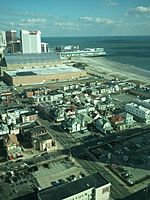
In 2006, Morgan Stanley purchased 20 acres (8.1 ha) directly north of the Showboat Atlantic City Hotel and Casino for a new $2 billion plus casino resort. Revel Entertainment Group was named as the project's developer for the Revel Casino. Revel was hindered with many problems, the biggest setback occurring in April 2010 when Morgan Stanley, the owner of 90% of Revel Entertainment Group, decided to discontinue funding for continued construction and put its stake in Revel up for sale. Early in 2010 the New Jersey state legislature passed a bill offering tax incentives to attract new investors and complete the job, but a poll by Fairleigh Dickinson University's PublicMind released in March 2010 showed that 60% of voters opposed the legislation, and two of three of those who opposed it "strongly" opposed it. Ultimately, Governor Chris Christie offered Revel $261 million in state tax credits to assist the casino once it opened. As of March 2011[update], Revel had completed all of the exterior work and had continued work on the interior after finally receiving the funding necessary to complete construction. It had a soft opening in April 2012, and was fully open by May 2012. Ten months later, in February 2013, after serious losses and a write-down in the value of the resort from $2.4 billion to $450 million, Revel filed for Chapter 11 bankruptcy. It was restructured but still could not carry on and re-entered bankruptcy on June 19, 2014. It was put up for sale, however as no suitable bids were received the resort closed its doors on September 2, 2014.
In the wake of the closures and declining revenue from casinos, Governor Christie said in September 2014 that the state would consider a 2015 referendum to end the 40-year-old monopoly that Atlantic City holds on casino gambling and allowing gambling in other municipalities. With casino revenue declining from $5.2 billion in 2006 to $2.9 billion in 2013, the state saw a drop in money from its 8% tax on those earnings, which is used to fund programs for senior citizens and the disabled.
"Superstorm Sandy" struck Atlantic City on October 29, 2012, causing flooding and power-outages but left minimal damage to any of the tourist areas including the Boardwalk and casino resorts, despite widespread belief that the city's boardwalk had been destroyed. The source of the misinformation was a widely circulated photograph of a damaged section of the Boardwalk that was slated for repairs, prior to the storm, and incorrect news reports at the time of the disaster. The storm produced an all-time record low barometric pressure reading of 943 mb (27.85") for not only Atlantic City, but the state of New Jersey.
Geography
According to the United States Census Bureau, the city had a total area of 17.037 square miles (44.125 km2), including 10.747 square miles (27.835 km2) of land and 6.290 square miles (16.290 km2) of water (36.92%).
The city is located on 8.1-mile (13.0 km) long Absecon Island, along with Ventnor City, Margate City and Longport to the southwest.
Unincorporated communities, localities and place names located partially or completely within the city include Chelsea, City Island, Great Island and Venice Park.
 |
Absecon | Galloway Township | Brigantine |  |
| Egg Harbor Township Pleasantville |
Atlantic Ocean | |||
| Egg Harbor Township Pleasantville |
Ventnor City Margate City |
Atlantic Ocean |
Climate
Atlantic City has a humid subtropical climate (Köppen Cfa), with some maritime moderation, especially during the summer.
Summers are typically warm and humid with a July daily average of 75.6 °F (24.2 °C). During this time, the city gets a sea breeze off the ocean that often makes daytime temperatures much cooler than inland areas, making Atlantic City a prime place for beating the summer heat from June through September. Average highs even just a few miles west of Atlantic City exceed 85 °F (29 °C) in July. Near the coast, temperatures reach or exceed 90 °F (32 °C) on an average of only 6.8 days a year, but this reaches 21 days at nearby Atlantic City International Airport. Winters are cool, with January averaging 35.5 °F (2 °C). Spring and autumn are erratic, although they are usually mild with low humidity. The average window for freezing temperatures is November 20 to March 25, allowing a growing season of 239 days. Extreme temperatures range from −9 °F (−23 °C) on February 9, 1934 to 104 °F (40 °C) on August 7, 1918.
Annual precipitation is 40 inches (1,020 mm) which is fairly spread throughout the year. Owing to its proximity to the Atlantic Ocean and its location in South Jersey, Atlantic City receives less snow than a good portion of the rest of New Jersey. Even at the airport, where low temperatures are often much lower than along the coast, snow averages only 16.5 inches (41.9 cm) each winter. It is very common for rain to fall in Atlantic City while the northern and western parts of the state are receiving snow.
| Climate data for Atlantic City, New Jersey (downtown), 1981–2010 normals, extremes 1874–present | |||||||||||||
|---|---|---|---|---|---|---|---|---|---|---|---|---|---|
| Month | Jan | Feb | Mar | Apr | May | Jun | Jul | Aug | Sep | Oct | Nov | Dec | Year |
| Record high °F (°C) | 72 (22) |
77 (25) |
84 (29) |
91 (33) |
95 (35) |
99 (37) |
102 (39) |
104 (40) |
94 (34) |
91 (33) |
80 (27) |
74 (23) |
104 (40) |
| Mean maximum °F (°C) | 59.3 (15.2) |
59.9 (15.5) |
68.4 (20.2) |
77.3 (25.2) |
83.7 (28.7) |
89.7 (32.1) |
93.5 (34.2) |
91.8 (33.2) |
86.3 (30.2) |
78.9 (26.1) |
70.1 (21.2) |
62.4 (16.9) |
95.3 (35.2) |
| Average high °F (°C) | 41.8 (5.4) |
43.5 (6.4) |
49.6 (9.8) |
57.6 (14.2) |
66.6 (19.2) |
75.7 (24.3) |
81.3 (27.4) |
80.2 (26.8) |
74.8 (23.8) |
65.0 (18.3) |
55.8 (13.2) |
46.3 (7.9) |
61.6 (16.4) |
| Average low °F (°C) | 29.2 (−1.6) |
30.9 (−0.6) |
36.9 (2.7) |
45.5 (7.5) |
54.5 (12.5) |
64.3 (17.9) |
70.0 (21.1) |
69.7 (20.9) |
63.5 (17.5) |
52.5 (11.4) |
42.9 (6.1) |
33.5 (0.8) |
49.5 (9.7) |
| Mean minimum °F (°C) | 11.3 (−11.5) |
16.3 (−8.7) |
22.4 (−5.3) |
33.8 (1.0) |
44.3 (6.8) |
53.7 (12.1) |
61.4 (16.3) |
60.1 (15.6) |
50.5 (10.3) |
39.2 (4.0) |
29.0 (−1.7) |
19.0 (−7.2) |
10.1 (−12.2) |
| Record low °F (°C) | −4 (−20) |
−9 (−23) |
8 (−13) |
15 (−9) |
33 (1) |
45 (7) |
52 (11) |
48 (9) |
37 (3) |
27 (−3) |
10 (−12) |
−7 (−22) |
−9 (−23) |
| Average precipitation inches (mm) | 3.08 (78) |
2.87 (73) |
4.02 (102) |
3.39 (86) |
3.22 (82) |
2.68 (68) |
3.31 (84) |
3.92 (100) |
3.08 (78) |
3.47 (88) |
3.35 (85) |
3.62 (92) |
40.01 (1,016) |
| Average snowfall inches (cm) | 4.5 (11) |
6.7 (17) |
1.1 (2.8) |
0.3 (0.76) |
0 (0) |
0 (0) |
0 (0) |
0 (0) |
0 (0) |
0 (0) |
0.2 (0.51) |
3.7 (9.4) |
16.5 (42) |
| Average precipitation days (≥ 0.01 in) | 9.3 | 9.0 | 10.5 | 10.9 | 10.4 | 8.7 | 8.4 | 8.0 | 7.7 | 7.6 | 8.9 | 10.4 | 109.8 |
| Average snowy days (≥ 0.1 in) | 2.9 | 2.8 | 0.9 | 0.3 | 0 | 0 | 0 | 0 | 0 | 0 | 0.1 | 1.7 | 8.7 |
| Average relative humidity (%) | 69.5 | 69.0 | 66.9 | 66.4 | 70.7 | 72.9 | 73.9 | 75.7 | 76.4 | 74.8 | 72.8 | 70.6 | 71.6 |
| Mean monthly sunshine hours | 150.8 | 157.9 | 204.5 | 218.9 | 243.9 | 266.2 | 276.3 | 271.3 | 227.6 | 200.5 | 147.4 | 133.8 | 2,499.1 |
| Percent possible sunshine | 50 | 53 | 55 | 55 | 55 | 60 | 61 | 64 | 61 | 58 | 49 | 46 | 56 |
| Source: NOAA (relative humidity and sun 1961–1990 and snow at Atlantic City Int'l) | |||||||||||||
Demographics
| Historical population | |||
|---|---|---|---|
| Census | Pop. | %± | |
| 1860 | 687 | — | |
| 1870 | 1,043 | 51.8% | |
| 1880 | 5,477 | 425.1% | |
| 1890 | 13,055 | 138.4% | |
| 1900 | 27,838 | 113.2% | |
| 1910 | 46,150 | 65.8% | |
| 1920 | 50,707 | 9.9% | |
| 1930 | 66,198 | 30.6% | |
| 1940 | 64,094 | −3.2% | |
| 1950 | 61,657 | −3.8% | |
| 1960 | 59,544 | −3.4% | |
| 1970 | 47,859 | −19.6% | |
| 1980 | 40,199 | −16.0% | |
| 1990 | 37,986 | −5.5% | |
| 2000 | 40,517 | 6.7% | |
| 2010 | 39,558 | −2.4% | |
| 2020 | 38,497 | −2.7% | |
| Population sources: 1860–2000 1860–1920 1870 1880–1890 1890–1910 1860–1930 1930–1990 2000 2010 2020 |
|||
2010 Census
As of the census of 2010, there were 39,558 people, 15,504 households, and 8,558 families residing in the city. The population density was 3,680.8 per square mile (1,421.2/km2). There were 20,013 housing units at an average density of 1,862.2 per square mile (719.0/km2)*. The racial makeup of the city was 26.65% (10,543) White, 38.29% (15,148) Black or African American, 0.61% (242) Native American, 15.55% (6,153) Asian, 0.05% (18) Pacific Islander, 14.03% (5,549) from other races, and 4.82% (1,905) from two or more races. [[Hispanic (U.S. Census)|Hispanic or Latino of any race were 30.45% (12,044) of the population.
There were 15,504 households out of which 27.3% had children under the age of 18 living with them, 25.9% were married couples living together, 22.2% had a female householder with no husband present, and 44.8% were non-families. 37.5% of all households were made up of individuals, and 14.3% had someone living alone who was 65 years of age or older. The average household size was 2.50 and the average family size was 3.34.
In the city, the population was spread out with 24.6% under the age of 18, 10.2% from 18 to 24, 26.8% from 25 to 44, 25.8% from 45 to 64, and 12.7% who were 65 years of age or older. The median age was 36.3 years. For every 100 females there were 96.2 males. For every 100 females ages 18 and old there were 94.4 males.
The Census Bureau's 2006–10 American Community Survey showed that (in 2010 inflation-adjusted dollars) median household income was $30,237 (with a margin of error of +/- $2,354) and the median family income was $35,488 (+/- $2,607). Males had a median income of $32,207 (+/- $1,641) versus $29,298 (+/- $1,380) for females. The per capita income for the city was $20,069 (+/- $2,532). About 23.1% of families and 25.3% of the population were below the poverty line, including 36.6% of those under age 18 and 16.8% of those age 65 or over.
Arts and culture
Monopoly
Atlantic City (sometimes referred to as "Monopoly City") has become well-known over the years for its portrayal in the U.S. version of the popular board game, Monopoly, in which properties on the board are named after locations in and near Atlantic City. While the original incarnation of the game did not feature Atlantic City, it was in Indianapolis that Ruth Hoskins learned the game, and took it back to Atlantic City. After she arrived, Hoskins made a new board with Atlantic City street names, and taught it to a group of friends, who ultimately passed in on to Charles Darrow, who made some modifications to the game and claimed it as his own invention.
Marvin Gardens, the leading yellow property on the board, is actually a misspelling of the original location name, "Marven Gardens". The misspelling was said to have been introduced by Charles Todd and passed on when his home-made Monopoly board was copied by Charles Darrow and thence Parker Brothers. It was not until 1995 that Parker Brothers acknowledged this mistake and formally apologized to the residents of Marven Gardens for the misspelling, although the spelling error was not corrected.
Some of the actual locations that correspond to board elements have changed since the game's release. Illinois Avenue was renamed Martin Luther King Jr. Blvd. in the 1980s. St. Charles Place no longer exists, as the Showboat Casino Hotel was developed where it once ran.
The "Short Line" is believed to refer to the Shore Fast Line, a streetcar line that served Atlantic City. The B&O Railroad did not serve Atlantic City. A booklet included with the reprinted 1935 edition states that the four railroads that served Atlantic City in the mid-1930s were the Jersey Central, the Seashore Lines, the Reading Railroad, and the Pennsylvania Railroad.
The actual "Electric Company" and "Water Works" serving the city are the Atlantic City Electric Company and the Atlantic City Municipal Utilities Authority, respectively.
Attractions
Ever since Atlantic City's growth as a resort town, numerous attractions and tourist traps have originated in the city. A popular fixture in the early 20th century at the Steel Pier was horse diving, which was introduced by William "Doc" Carver. The Steel Pier featured several other novelty attractions, including the Diving Bell, human high-divers and a water circus. Advertisements for the Steel Pier in its heyday featured plaster sculptures set upon wooden bases along roads leading up to Atlantic City. By the end of World War II, many animal demonstrations declined in popularity after criticisms of animal abuse and neglect.
Rolling chairs, which were introduced in 1876 and in continuous use since 1887, have been a boardwalk fixture to this day. While powered carts appeared in the 1960s, the original and most common were made of wicker. The wicker canopied chairs-on-wheels are manually pushed the length of the boardwalk by attendants, much like a Rickshaw.
The Absecon Lighthouse is a coastal lighthouse located in the South Inlet section of Atlantic City overlooking Absecon Inlet. It is the tallest lighthouse in the state of New Jersey and is the third tallest masonry lighthouse in the United States. Construction began in 1854, with the light first lit on January 15, 1857. The lighthouse was deactivated in 1933 and although the light still shines every night, it is no longer an active navigational aid. Gardner's Basin, which is home to the Atlantic City Aquarium as well as small shops and restaurants, is located a short distance north of Absecon Light.
Since 2003, Atlantic City has hosted Thunder over the Boardwalk, an annual airshow over the boardwalk. The yearly event, a joint venture between the New Jersey Air National Guard's 177th Fighter Wing along with several casinos, attracts over 750,000 visitors each year.
While located 2 miles (3.2 km) south of Atlantic City in Margate City, Lucy the Elephant has become almost an icon for the Atlantic City area. Lucy is a six-story elephant-shaped example of novelty architecture, constructed of wood and tin sheeting in 1882 by James V. Lafferty in an effort to sell real estate and attract tourism. Over the years, Lucy had served as a restaurant, business office, cottage, and tavern (the last closed by Prohibition). Lucy had fallen into disrepair by the 1960s and was scheduled for demolition. The structure was moved and refurbished as a result of a "Save Lucy" campaign in 1970 and received designation as a National Historic Landmark in 1976, and is open as a museum.
Miss America pageant
Atlantic City is the home of the Miss America competition, however it was moved to Las Vegas for seven years before returning. The Miss America competition originated on September 7, 1921, as a two-day beauty contest, and it included state contestants as well as women from various cities around the country. The event that year was called the "Atlantic City Pageant", and the winner of the grand prize, Margaret Gorman, took home the 3-foot Golden Mermaid trophy. Gorman was not called "Miss America" until 1922, when she re-entered the pageant and lost to Mary Campbell. The pageant was initiated to extend the tourist season after the Labor Day weekend. The pageant has been nationally televised since 1954. It peaked in the early 1960s, when it was repeatedly the highest-rated program on American television. It was seen as a symbol of the United States, with Miss America often being referred to as the female equivalent of the President. The pageant's longtime emcee, Bert Parks, hosted the event from 1955 to 1979. At the Atlantic City Convention Center, there is an interactive statue of Parks holding a crown. When a visitor puts their head inside the crown, sensors activate a recorded playback of his "There She Is..." line through speakers hidden behind nearby bushes.
Since the departure of the Miss America pageant from the city, an LGBT event known as the "Miss'd America Pageant" is held annually at the Boardwalk Hall. Originally started in 1994 as a fundraiser for local LGBT charities, the event features drag queens on the runway in a similar manner to the Miss America pageant.
Boardwalk Empire
Since 2010, Boardwalk Empire, an American television series from cable network HBO set in Atlantic City during the Prohibition era, has cast a new light on the city. Starring Steve Buscemi, the show was adapted from a chapter about historical criminal kingpin Enoch "Nucky" Johnson (who is renamed "Enoch Thompson" in the show) in Nelson Johnson's book, Boardwalk Empire: The Birth, High Times, and Corruption of Atlantic City. The series was filmed in New York City at various locations that captured Atlantic City's period architecture and on a set built to resemble the Atlantic City boardwalk in the 1920s.
Around the same time of the September 2010 premiere of the show, the Press of Atlantic City created Boss of the Boardwalk, a 45-minute documentary which premiered on August 21, 2010 on NBC TV-40 and aired six additional times in the following weeks.
After the premiere of Boardwalk Empire, interest in Roaring Twenties-era Atlantic City has grown. In October 2010, a plan was revealed to renovate the ailing Resorts Casino Hotel into a Roaring Twenties theme. The re-branding was proposed by current owner Dennis Gomes, and was initiated in December 2010 when he took over the casino. The changes accentuate the resort's existing art deco design, as well as presenting new 20s-era uniforms for employees and music from the time period. The casino also introduced drinks and shows reminiscent of the period. The actual building where he lived, The Ritz-Carlton, offer tours.
In 2011, Academy Bus began a trolley tour called "Nucky's Way", a tour bus service that features actors portraying Nucky, as well as other characters, as it loops around the city. Nucky's Way is the second trolley tour to capitalize off of Boardwalk Empire, after The Great American Trolley company started a weekly tour of Atlantic City with a Roaring Twenties theme in early June 2011.
On August 1, 2011, a façade modeled after the set of Boardwalk Empire was unveiled on the boardwalk in front of an empty lot at the former site of the Trump World's Fair resort. The façade of storefronts, which consists of vinyl tacked onto three large sections of plywood, was the brainchild of longtime area radio host Pinky Kravitz, who was also a columnist for The Press of Atlantic City and host of WMGM Presents Pinky on NBC40.
Beach concerts
In 2014, it was announced that Atlantic City would host two major beach concerts. The two headliners were Blake Shelton, which took place on July 31, 2015 and Lady Antebellum, which took place on August 3, 2014. On June 22, 2015, it was announced that Maroon 5 with special guest Nick Jonas and Matt McAndrew would headline on August 16, 2015. A few weeks later, it was announced that Rascal Flatts would play the second major beach concert of the summer season on August 20, 2015, with special guest Ashley Monroe. This concert would be part of their Riot Tour. Both concerts charged admission.
Parks and recreation
Atlantic City is one of five municipalities in the state—and the only one outside of Cape May County—that offer free public access to oceanfront beaches monitored by lifeguards, joining Wildwood, North Wildwood, Wildwood Crest and Upper Township's Strathmere section.
In popular culture
In addition to the city's exposure in the HBO series Boardwalk Empire, Atlantic City has been featured in several other aspects of pop culture.
In film
- A majority of the 1972 film The King of Marvin Gardens takes place in a snow-covered Atlantic City prior to casino gambling.
- The 1980 movie, Atlantic City, took place in various parts of the city.
- The 1984 movie Desperately Seeking Susan features some scenes shot in Atlantic City.
- The protagonists in the 1988 film Beaches are shown having their first meeting under the Atlantic City boardwalk as children, in 1958.
- The 1990 film The Godfather Part III includes a scene in which a helicopter attacks a meeting of Mafia bosses including protagonist Michael Corleone taking place in a penthouse at an Atlantic City hotel.
- The 1998 film, Snake Eyes, was set at a boxing match inside Trump Taj Mahal in Atlantic City.
- Part of the 2010 movie, The Bounty Hunter, takes place at the Borgata and Trump Taj Mahal.
- One of the early fights in the 2010 film, The Fighter, took place in Atlantic City.
- One of the fights in the 2011 movie, Warrior, takes place inside Boardwalk Hall, with the post-fight press conference taking place on the boardwalk and a pre-fight talk between the two brothers taking place on the beach outside Trump Plaza.
- Rounders includes scenes filmed in the Taj Mahal poker room.
In television
- The 1954 TV series On the Boardwalk with Paul Whiteman was shot at the Steel Pier in Atlantic City.
- The 1960 animated TV series The Flintstones episode "The Buffalo Convention" has Fred and Barney fooling their wives, in order to go to the Water Buffalo Convention, which is being held at Frantic City.
- The 1980 TV series Big Shamus, Little Shamus is set at a fictional Atlantic City casino, starring Brian Dennehy as a house detective.
- The short-lived 1988 game show Yahtzee was taped in Atlantic City, first originating from Trump Castle before moving to the Showboat.
- The 1990 game show Trump Card was filmed at the Trump Castle.
- The short-lived 1991 game show Ruckus, which aired locally on WNBC in New York City, was taped at Resorts Casino Hotel, then owned by the show's producer, Merv Griffin.
- The 1993 The X files episode "The Jersey Devil" is mainly set in Atlantic City.
- The 2002 Sex and The City episode "Luck Be An Old Lady" is set in Atlantic City.
- The 2004 The Simpsons episode "Catch 'Em If You Can" is set partly in Atlantic City.
- The 2006 episode "Atlantic City" of the TV series How I Met Your Mother is set in Atlantic City.
- The 2009 series Life After People showed the cities casinos, hotels, and boardwalk collapsing with no people to maintain the city. It is shown as being unrecognizable after 200 years, sooner than most cities due to hurricanes, salty air promoting corrosion and rising sea levels.
- The 2010 TV series Boardwalk Empire is set primarily in Atlantic City.
- Part of the 2012 Family Guy episode "Joe's Revenge" is set in Atlantic City.
- The Real Housewives of New Jersey Season 2 Reunion was recorded on a set at Borgata. The Season 1 episode, "Casinos and C-Cups" was also filmed in the city. Also promotional photo of original cast shot on Boardwalk.
- The Criminal Minds episode "The Uncanny Valley" (the twelfth episode of the show's fifth season) deals with a suspect with an unusual obsession in Atlantic City.
- The 2011 Castle (TV series) episode "Heartbreak Hotel" is set partly in Atlantic City.
In literature
- Harlan Coben's 2012 novel, Stay Close is almost entirely set in Atlantic City.
- Judy Blume's 1981 novel, Tiger Eyes, is partially set in Atlantic City; the family temporarily relocate to New Mexico after a tragic event.
- A Marvel Comics one-shot comic book starring Wolverine, entitled "Under The Boardwalk" takes place in Atlantic City in the form of one of the titular character's flashbacks.
- Imitation of Life – First appearing with a different title as a serialized novel in a periodical, later this best-seller by Fannie Hurst was twice interpreted by Hollywood. Set in early 20th century Atlantic City.
Gallery
Economy
As of September 2014, the greater Atlantic City area had one of the highest unemployment rates in the country at 13.8%, out of labor force of around 141,000.
Tourism district
In July 2010, Governor Chris Christie announced that a state takeover of the city and local government "was imminent". Comparing regulations in Atlantic City to an "antique car", Atlantic City regulatory reform is a key piece of Governor Chris Christie's plan, unveiled on July 22, to reinvigorate an industry mired in a four-year slump in revenue and hammered by fresh competition from casinos in the surrounding states of Delaware, Pennsylvania, Connecticut, and more recently, Maryland. In January 2011, Chris Christie announced the creation of the Atlantic City Tourism District, a state-run district encompassing the boardwalk casinos, the marina casinos, the Atlantic City Outlets, and Bader Field. Fairleigh Dickinson University's PublicMind poll surveyed New Jersey voters' attitudes on the takeover. February 16, 2011, survey showed that 43% opposed the measure while 29% favored direct state oversight. The poll also found that even South Jersey voters expressed opposition to the plan; 40% reported they opposed the measure and 37% reported they were in favor of it.
On April 29, 2011, the boundaries for the state-run tourism district were set. The district would include heavier police presence, as well as beautification and infrastructure improvements. The CRDA would oversee all functions of the district and make changes to attract new businesses and attractions. New construction will be ambitious and may resort to eminent domain.
The tourism district would comprise several key areas in the city; the Marina District, Ducktown, Chelsea, South Inlet, Bader Field, and Gardner's Basin. Also included are 10 roadways that lead into the district, including several in the city's northern end, or North Beach. Gardner's Basin, which is home to the Atlantic City Aquarium, was initially left out of the tourism district, while a residential neighborhood in the Chelsea section was removed from the final boundaries, owing to complaints from the city. Also, the inclusion of Bader Field in the district was controversial and received much scrutiny from mayor Lorenzo Langford, who cast the lone "no" vote on the creation of the district citing its inclusion.
Shopping
Atlantic City has many different shopping districts and malls, many of which are located inside or adjacent to the casino resorts. Several smaller themed retail and dining areas in casino hotels include the Borgata Shops and The Shoppes at Water Club inside the Borgata, the Waterfront Shops inside of Harrah's, Spice Road inside the Trump Taj Mahal, while Resorts Casino Hotel has a small collection of stores and restaurants. Major shopping malls are also located in and around Atlantic City.
In Atlantic City, shops include:
- Playground Pier, an underwater-themed indoor high end shopping center located on the Million Dollar Pier formerly known as "Shops on Ocean One". The four-story shopping mall contains themed floors.
- Tanger Outlets The Walk, an outdoor outlet shopping center spanning several blocks. The only outlet mall in Atlantic County, The Walk opened in 2003 and is undergoing an expansion.
- The Quarter at Tropicana, an old Havana-themed indoor shopping center at the Tropicana, which contains over 40 stores, restaurants, and nightclubs.
Exhibition
Boardwalk Hall, formally known as the "Historic Atlantic City Convention Hall", is an arena in Atlantic City along the boardwalk. Boardwalk Hall was Atlantic City's primary convention center until the opening of the Atlantic City Convention Center in 1997. The Atlantic City Convention Center includes 500,000 sq ft (46,000 m2) of showroom space, 5 exhibit halls, 45 meeting rooms with 109,000 sq ft (10,100 m2) of space, a garage with 1,400 parking spaces, and an adjacent Sheraton hotel. Both the Boardwalk Hall and Convention Center are operated by the Atlantic City Convention & Visitors Authority.
Sports
| Club | Sport | League | Venue | Year(s) |
| Atlantic City Blackjacks | Arena football | AFL | Boardwalk Hall | 2019 |
| Atlantic City FC | Soccer | NPSL | Silver Eagle Stadium | 2018–present |
| Atlantic City Diablos | Soccer | NPSL | St. Augustine College Preparatory School | 2007–2008 |
| Atlantic City Boardwalk Bullies | Ice Hockey | ECHL | Boardwalk Hall | 2001–2005 |
| Atlantic City CardSharks | Indoor football | NIFL | Boardwalk Hall | 2004 |
| Atlantic City Surf | Baseball | Can-Am League | Bernie Robbins Stadium | 1998–2008 |
| Atlantic City Seagulls | Basketball | USBL | Atlantic City High School | 1996–2001 |
The Atlantic City Race Course in Hamilton Township was a horse racing track that operated from 1946 to 2015.
The ShopRite LPGA Classic is an LPGA Tour women's golf tournament held near Atlantic City since it started in 1986.
Professional boxing
Since February 2, 1887, the city of Atlantic City has seen 2,538 (as of September 2018) professional boxing fight programs, the first one being one with a main event fight between Willie Clark, 3-0-3, and debuting Horace Leeds, won by Clark on points over four rounds. During the 1980s, professional boxing activity boomed in Atlantic City, at times rivaling Las Vegas, Nevada, in staging major boxing fights. Fighters who fought in Atlantic City at that era include Marvelous Marvin Hagler, Thomas Hearns, Wilfredo Gómez, Jeff Chandler, Larry Holmes, George Foreman, Mike Tyson and others. Fights included The Brawl For it All, Tyson versus Holmes, Tyson versus Michael Spinks, and Roberto Durán versus Iran Barkley.
Many boxing matches were held at Donald Trump's Trump Plaza, promoted either by Bob Arum or Don King.
Education
The Atlantic City School District serves students in pre-kindergarten through twelfth grades. As of the 2017–18 school year, the eleven schools in the district had a combined enrollment of 7,157 students and a faculty of 614.9 classroom teachers (on an FTE basis) for a student–teacher ratio of 11.6:1. Schools in the district (with 2017–18 enrollment data from the National Center for Education Statistics) are Venice Park School (75 students in PreK), Brighton Avenue School (346 students; in grades PreK–5), Chelsea Heights School (367; PreK–8), Dr. Martin Luther King Jr. School Complex (599; PreK–8), New York Avenue School (605; PreK–8), Pennsylvania Avenue School (559; PreK–8), Richmond Avenue School (715; PreK–8), Sovereign Avenue School (736; PreK–8), Texas Avenue School (560; K–8), Uptown School Complex (572; PreK–8) and Atlantic City High School (1,882; 9–12). Pennsylvania Avenue School opened for the 2012–13 school year, with most students shifting from New Jersey Avenue School, which had been one of the district's oldest and most rundown schools.
Students from Brigantine, Longport, Margate City and Ventnor City attend Atlantic City High School as part of sending/receiving relationships with the respective school districts.
City public school students are also eligible to attend the Atlantic County Institute of Technology in the Mays Landing section of Hamilton Township or the Charter-Tech High School for the Performing Arts, located in Somers Point.
Oceanside Charter School, which offered pre-Kindergarten through eighth grade, was founded in 1999 and closed in June 2013 when its charter wasn't renewed by the New Jersey Department of Education.
Founded in 1908, Our Lady Star of the Sea Regional School is a Catholic elementary school, operated under the jurisdiction of the Diocese of Camden.
Nearby college campuses include those of Atlantic Cape Community College and Stockton University, the latter of which offers classes and resources in the city such as the Carnegie Library Center.
Infrastructure
Transportation
Roads and highways
As of May 2010[update], the city had a total of 103.67 mi (166.84 km) of roadways, of which 88.26 mi (142.04 km) were maintained by the municipality, 1.29 mi (2.08 km) by Atlantic County, 5.32 mi (8.56 km) by the New Jersey Department of Transportation and 8.80 mi (14.16 km) by the South Jersey Transportation Authority.
The three roadways into Atlantic City are the Black Horse Pike/Harding Highway (US 322/40 via the Albany Avenue drawbridge), White Horse Pike (US 30), and the Atlantic City Expressway (including the Brigantine Connector). Atlantic City is roughly 132 mi (212 km) south of New York City by road (via the Garden State Parkway) and 55 mi (89 km) southeast of Philadelphia.
Public transportation
Atlantic City is connected to other cities in several ways. NJ Transit's Atlantic City Rail Terminal at the Atlantic City Convention Center provides service from 30th Street Station in Philadelphia through several smaller South Jersey communities via the Atlantic City Line.
On June 20, 2006, the board of NJ Transit approved a three-year trial of express train service between New York Penn Station and the Atlantic City Rail Terminal. The line, known as ACES (Atlantic City Express Service), ran from February 2009 to March 2012. The approximate travel time was 2+1⁄2 hours, with a stop at Newark's Penn Station, and was part of the casinos' multimillion-dollar investments in Atlantic City. Most of the funding for the transit line was provided by Harrah's Entertainment (owners of both Harrah's Atlantic City and Caesars Atlantic City) and the Borgata.
The Atlantic City Bus Terminal is the home to local, intrastate and interstate bus companies including NJ Transit, OurBus and Greyhound bus lines. The Greyhound Lucky Streak Express offers service to Atlantic City from New York City, Brooklyn, Philadelphia, Baltimore, and Washington, D.C. In addition to stopping at the Atlantic City Bus Terminal, Greyhound buses stop at various casinos in Atlantic City. Martz Trailways provides bus service to various casinos in Atlantic City from Wilkes-Barre, Scranton, and White Haven in Pennsylvania. Klein Transportation provides bus service to various casinos in Atlantic City from Shillington, Douglassville, Royersford, and Audubon in Pennsylvania.
Within the city, public transportation is provided by NJ Transit along 13 routes, including service between the city and the Port Authority Bus Terminal in Midtown Manhattan on the 319 route, and service to and from Atlantic City on routes 501 (to Brigantine Beach), 502 (to Atlantic Cape Community College), 504 (to Ventnor Plaza), 505 (to Longport), 507 (to Ocean City), 508 (to the Hamilton Mall), 509 (to Ocean City), 551 (to Philadelphia), 552 (to Cape May), 553 (to Upper Deerfield Township), 554 (to the Lindenwold PATCO station) and 559 (to Lakewood Township).
The Atlantic City Jitney Association (ACJA) offers service on four fixed-route lines and on shuttles to and from the rail terminal.
Airline service
Commercial airlines serve Atlantic City via Atlantic City International Airport, located 9 mi (14 km) northwest of the city in Egg Harbor Township. Many travelers also fly into Philadelphia International Airport, Trenton-Mercer Airport, or Newark Liberty International Airport, where there are wider selections of carriers from which to choose. The historic downtown Bader Field airport is now permanently closed and plans are in the works to redevelop the land.
Atlantic City International Airport is a focus city for Spirit Airlines. The airport is also served by various scheduled chartered flight companies.
Healthcare
The AtlantiCare Regional Medical Center is a health system based in Atlantic City. Founded in 1898, it includes two hospitals; the Atlantic City Campus and the Mainland Campus in Pomona, New Jersey. It has Atlantic City's only cancer institute, heart institute, and neonatal intensive care unit.
Utilities
South Jersey Industries provides natural gas to the city under the South Jersey Gas division. Marina Energy and its subsidiary, Energenic, a joint business venture with a long-time business partner, operate two thermal power stations in the city. The Marina Thermal Plant serves the Borgata while a second plant serves the Resorts Hotel and Casino. Another thermal plant is the Midtown Thermal Control Center on Atlantic and Ohio Avenues built by Conectiv, which opened in 1997 and provides chilled water for hotels and other facilities along the Boardwalk.
Electrical power in Atlantic City as well as the surrounding area is primarily served by Atlantic City Electric, which was incorporated in 1924 and provides power from the Beesley's Point Generating Station in Upper Township, as well as other locations.
The Jersey-Atlantic Wind Farm, opened in 2005, is the first onshore coastal wind farm in the United States. In October 2010, North American Offshore Wind Conference was held in the city and included tours of the facility and potential sites for further development. In February 2011, the state passed legislation permitting the construction of windmills for electricity along pre-existing piers, such as the Steel Pier. The first phase of the Atlantic Wind Connection, a planned electrical transmission backbone along the Jersey Shore was planned to be operational in 2013.
Notable people
People who were born in, residents of, or otherwise closely associated with Atlantic City include:
- Jack Abramoff (born 1958), former lobbyist who was embroiled in high-profile political scandals. Abramoff was born in Atlantic City and lived there until age 10.
- Robert Agnew (born 1953), professor of sociology at Emory University and president of the American Society of Criminology.
- Joe Albany (1924–1988), jazz pianist.
- James Avery (1945–2013), actor best known for portrayal of patriarch Philip Banks, Will Smith's character's uncle, in TV series The Fresh Prince of Bel-Air.
- Harry Bacharach (1873–1947), mayor of Atlantic City in 1912 for six months, again from 1916 to 1920, and again from 1930 to 1935.
- Isaac Bacharach (1870–1956), represented NJ's 2nd congressional district from 1915 to 1937.
- Edward L. Bader (1874–1927), mayor from 1920 to 1927.
- Joseph Carleton Beal (1900–1967), co-writer of the Christmas song Jingle Bell Rock.
- Barry Beckham (born 1944), playwright and novelist.
- Edwin Blum (1906–1995), screenwriter for films Stalag 17 and The New Adventures of Tarzan.
- Jack Boucher (1931–2012), photographer for National Park Service for more than 40 years beginning in 1958, chief photographer for the Historic American Buildings Survey.
- Horace J. Bryant (1909–1983), first African American to serve in a State Cabinet position in New Jersey.
- Benjamin Burnley (born 1978), musician, best known as lead vocalist, rhythm guitarist and primary songwriter for band Breaking Benjamin.
- Greg Buttle (born 1954), linebacker who played in the NFL for the New York Jets.
- Mark H. Buzby (born 1956), former United States Navy rear admiral who serves as Administrator of the United States Maritime Administration.
- Carole Byard (1941–2017), visual artist and illustrator of children's books, who was the recipient of a Caldecott Medal and multiple Coretta Scott King Awards.
- Harry Carroll (1892–1962), songwriter who composed music for "I'm Always Chasing Rainbows", "The Trail of the Lonesome Pine" and "By the Beautiful Sea".
- Rosalind Cash (1938–1995), actress nominated for an Emmy Award for PBS production of Go Tell It on the Mountain.
- Rocky Castellani (1926–2008), middleweight boxer best known for split-decision loss to Sugar Ray Robinson in which he knocked Robinson down in the sixth round.
- Vera Coking, property owner who prevailed in her battle to oppose Donald Trump's efforts to acquire her boarding house using eminent domain.
- Jack Collins (born 1943), Speaker of the New Jersey General Assembly from 1996 until 2002, making him the longest-serving speaker in Assembly history.
- Lawrence J. Delaney (born 1935), scientist and businessman who served as Assistant Secretary of the Air Force (Acquisition)
- Stuart Dischell (born 1954), poet and professor of English at University of North Carolina at Greensboro.
- Bruce Ditmas (born 1946), jazz drummer and percussionist.
- Sidney Drell (1926–2016), theoretical physicist and arms control expert.
- Robert Ettinger (1918–2011), academic, known as "the father of cryonics" based on the impact of his 1962 book The Prospect of Immortality.
- Frank S. Farley (1901–1977), member of New Jersey Legislature for 34 years, boss of Republican political machine that controlled the Atlantic City and Atlantic County governments.
- Vera King Farris (1938–2009), third president of Stockton University.
- Andrew Fields, collegiate basketball coach and a retired professional basketball player.
- Chris Ford (born 1949), head coach of the Boston Celtics, Milwaukee Bucks, Los Angeles Clippers and Philadelphia 76ers.
- Helen Forrest (1917–1999), singer for three of the most popular big bands of the Swing Era, earning reputation as "the voice of the name bands."
- Anne Francine (1917–1999), actress and cabaret singer.
- John F. Gaffney (1934–1995), politician who served in the New Jersey General Assembly, where he represented the 2nd Legislative District from 1992 until his death.
- John J. Gardner (1845–1921), represented New Jersey's 2nd congressional district from 1885 to 1893, mayor of Atlantic City 1868–75.
- Patsy Garrett (born 1921), actress.
- Milton W. Glenn (1903–1967), represented New Jersey's 2nd congressional district from 1957 to 1965.
- William Green (born 1979), NFL running back who played for the Cleveland Browns.
- Marjorie Guthrie (1917–1983), dancer of the Martha Graham Company and dance teacher who was the wife of folk musician Woody Guthrie.
- John R. Hargrove Sr. (born 1923), federal judge appointed by President Ronald Reagan to the United States District Court for the District of Maryland.
- Celestine Tate Harrington (1956–1998), quadriplegic street musician known for playing keyboard with her lips, teeth and tongue on the Atlantic City boardwalk.
- James Hillman (1926–2011), developer of archetypal psychology.
- Pete Hunter (born 1980), cornerback who played in the NFL for the Seattle Seahawks.
- Walter S. Jeffries (1893–1954), represented NJ's 2nd congressional district from 1939 to 1941.
- Candy Jones (1925–1990), fashion model, writer and radio talk show host.
- Allan Kaprow (1927–2006), painter and pioneer in establishing concepts of performance art, who influenced Fluxus.
- Amy Kennedy (born 1978), educator, mental health advocate and politician who is the Democratic Party nominee in the 2020 elections seeking to represent New Jersey's 2nd congressional district.
- Marie Kibler (1912–1978), artistic gymnast who competed at the 1936 Summer Olympics and placed fifth with the American team.
- Pinky Kravitz (1927–2015), radio broadcaster and print journalist who hosted "Pinky's Corner" on WOND from an array of Atlantic City locations from 1958 until a few months before his death in 2015, hosted "WMGM presents Pinky!" for years on WMGM-TV and wrote columns for many periodicals including The Press of Atlantic City.
- Martha Krebs, theoretical physicist who directed the Office of Science and Technology Policy for the United States Department of Energy and is the founding director for the California NanoSystems Institute at UCLA.
- JoAnna LaSane (1935–2019), model, dancer and arts administrator.
- Lee B. Laskin (born 1936), attorney, politician and judge who served in both houses of the New Jersey Legislature before being appointed to serve on the New Jersey Superior Court.
- Jacob Lawrence (1917–2000), artist known for depicting African-American life in his paintings. Born on Arctic Avenue.
- E. Grey Lewis (1940–2005), lawyer who served as General Counsel of the Navy.
- Bill Libby (1927–1984), sportswriter and biographer best known for his books on sports, including 65 on sports figures.
- James J. McCullough (born 1942), politician who served in the New Jersey Senate from 2007 to 2008, where he represented the 2nd Legislative District.
- Don McGahn (born 1968), White House Counsel and Assistant to the President for U.S. President Donald Trump and a former Commissioner of the United States Federal Election Commission.
- Bob Merrill (1921–1998), songwriter and screenwriter.
- John P. O'Neill (1952–2001), FBI terrorist specialist who was director of security at the World Trade Center and died in the September 11th, 2001 terrorist attacks.
- Joshua Ozersky (1967–2015), food writer and historian.
- Chris Pallies (1957-2019), professional wrestler known as King Kong Bundy.
- Reese Palley (1922 – 2015), “Merchant to the Rich”, entrepreneur, art dealer, writer, and sailor.
- Joseph B. Perskie (1885–1957), Associate Justice of the New Jersey Supreme Court from 1933 to 1947.
- Twiggy Ramirez (born 1971), bass player and guitarist for metal band Marilyn Manson.
- Monique Samuels, television personality best known as a cast member of the reality television series The Real Housewives of Potomac.
- Jeremy Slate (1926–2006), actor and songwriter.
- Alfredo Silipigni (1932–2006), conductor and founder of New Jersey State Opera.
- George Smathers (1913–2007), United States Senator from Florida.
- Dave Thomas (1932–2002), founder of Wendy's fast-food restaurant, was born in Atlantic City.
- Jean Webster (1935–2011), cook who operated Sister Jean's Kitchen, a soup kitchen serving free meals to the poor of Atlantic City.
- Jim Whelan (1948–2017), member of State Senate who represented the 2nd Legislative District until his death and was Mayor of Atlantic City from 1990 to 2001.
- Norman Joseph Woodland (1921–2012), inventor of the barcode.
- Albert Zugsmith (1910–1993), film producer.
Images for kids
-
Consilio et prudentia, Atlantic City's motto, along with its coat of arms on historic Boardwalk Hall, built during Prohibition
-
Station 5; Bader Field. Engine 5, Air Cascade Unit 1
See also
 In Spanish: Atlantic City (Nueva Jersey) para niños
In Spanish: Atlantic City (Nueva Jersey) para niños


